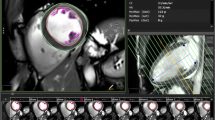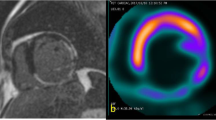Abstract
Aim: 18F-fluorodeoxyglucose (18F-FDG)-positron emission tomography (PET) provides information about myocardial glucose metabolism to diagnose myocardial viability. Additional information about the functional status is necessary. Comparison of tomographic metabolic PET with data from other imaging techniques is always hampered by some transfer uncertainty and scatter. We wanted to evaluate a new Fourier-based ECG-gated PET technique using a high resolution scanner providing both metabolic and functional data with respect to feasibility in patients with diseased left ventricles. Methods: Forty-five patients with coronary artery disease and at least one left ventricular segment with severe hypokinesis or akinesis at biplane cineventriculography were included. A new Fourier-based ECG-gated metabolic 18F-FDG-PET was performed in these patients. Function at rest and 18F-FDG uptake were examined in the PET study using a 36-segment model. Results: Segmental comparison with ventriculography revealed a high reliability in identifying dysfunctional segments (>96%). 18F-FDG uptake of normokinetic/hypokinetic/akinetic segments was 75.4 ± 7.5, 65.3 ± 10.5, and 35.9 ± 15.2% (p < 0.001). In segments ≥70% 18F-FDG uptake no akinesia was observed. No residual function was found below 40% 18F-FDG uptake. An additional dobutamine test was performed and revealed inotropic reserve (viability) in 42 akinetic segments and 45 hypokinetic segments. Conclusion: ECG-gated metabolic PET with pixel-based Fourier smoothing provides reliable data on regional function. Assessment of metabolism and function makes complete judgement of segmental status feasible within a single study without any transfer artefacts or test-to-test variability. The results indicate the presence of considerable amounts of viable myocardium in regions with an uptake of 40–50% 18F-FDG.
Similar content being viewed by others
References
Beanlands RSB, Hendry PJ, Masters RG, deKemp RA, Woodend K, Ruddy TD. Delay in revascularization is associated with increased mortality rate in patients with severe left ventricular dysfunction and viable myocardium on fluorine 18-fluorodeoxyglucose positron emission tomography imaging. Circulation 1998; 98: II51–II56.
Braunwald E, Kloner RA. The stunned myocardium: prolonged postischemic ventricular dysfunction. Circulation 1982; 66: 1146–1149.
Hoffmeister HM, Ströbele M, Bäßler A, Beyer ME, Kazmaier S, Seipel L. Preconditioning preserves energy metabolism in prolonged low-flow ischemia. Basic Res Cardiol 1998; 93: 487–496.
Rahimtoola SH. The hibernating myocardium. Am Heart J 1989; 117: 211–221.
Dilsizian V, Rocco TP, Freedman NMT, Leon MB, Bonow RO. Enhanced detection of ischemic but viable myocardium by the reinjection of thallium after stress-redistribution imaging. N Engl J Med 1990; 323: 141–146.
Di Carli MF. Predicting improved function after myocardial revascularization. Current Opinion Cardiol 1998; 13: 415–424.
Tamaki N, Kawamoto M, Tadamura E, et al. Prediction of reversible ischemia after revascularization. Circulation 1995; 91: 1697–1705.
Arnese M, Cornel JH, Salustri A, et al. Prediction of improvement of regional left ventricular function after surgical revascularization: a comparison of low-dose dobutamine echocardiography with 201T1 single photon emission computed tomography. Circulation 1995; 91: 2748–2752.
Baer FA, Voth E, Schneider CA, Theissen P, Schicha H, Sechtem U. Comparison of low-dose dobutamine-gradient-echo magnetic resonance imaging and positron emission tomography with 18F-fluorodeoxyglucose in patients with chronic coronary artery disease. Circulation 1995; 91: 1006–1015.
Cigarroa CG, deFilippi CR, Brickner E, Alvarez LG, Wait MA, Grayburn PA. Dobutamine stress echocardiography identifies hibernating myocardium and predicts recovery of left ventricular function after coronary revascularization. Circulation 1993; 88: 430–436.
Helfant RH, Pine R, Meister SG, Feldman MS, Trout RG, Banka VS. Nitroglycerin to unmask reversible asynergy: correlation with postcoronary bypass ventriculography. Circulation 1974; 50: 108–113.
Horn HR, Teichholz LE, Cohen PF, Herman MV, Gorlin R. Augmentation of left ventricular contraction patency in coronary artery disease by an inotropic catecholamine: the epinephrine ventriculogram. Circulation 1974; 49: 1063–1071.
Nesto RW, Cohn LH, Collins JJ, Wynne J, Holman L, Cohn PF. Inotropic contractile reserve: a useful predictor of increased 5-year survival and improved postoperative left ventricular function in patients with coronary artery disease and reduced ejection fraction. Am J Cardiol 1982; 50: 39–44.
Perrone-Filardi P, Bacharach SL, Dilsizian V, Maurea S, Frank JA, Bonow RO. Regional left ventricular wall thickening. Circulation 1992; 86: 1125–1137.
Popio KA, Gorlin R, Bechtel D, Levine JA. Post-extrasystolic potentiation as a predictor of potential myocardial viability: preoperative analyses compared with studies after coronary bypass surgery. Am J Cardiol 1977; 39: 944–953.
Müller-Schauenburg W, Hoffmeister HM, Renemann M, Helber U, Lietzenmeyer R, Feine U. Gated cardiac FDG PET improved by FOURIER analysis in comparison with cineventriculography. J Nucl Med 1995; 36: 141P.
Austen WG, Edwards JE, Frye RL, et al. A reporting system on patients evaluated for coronary artery disease. AHA Committee Report. Circulation 1975; 3–40.
Marwick TH. Stress Echocardiography: Its Role in the Diagnosis and Evaluation of Coronary Artery Disease. Developments in Cardiovascular Medicine. Vol. 149. Dordrecht/Boston/London: Kluwer Academic Publishers 1994.
Hoffman EJ, Phelps ME, Wisenberg G, Schelbert HR, Kuhl DE. Electrocardiographic gating in positron emission computed tomography. J Comput Assist Tomogr 1979; 3: 733–739.
Hör G, Kranert WT, Maul FD, Schröder O, Karimian-Tatriz A, Geb O, Baum RP, Scherer UW. Gated metabolic positron emission tomography (GAPET) of the myocardium: 18F-FDG-PET to optimize recognition of mycardial hibernation. Nucl Med Commun 1998; 19: 535–545.
Porenta G, Kuhle W, Sinha S, et al. Parameter estimation of cardiac geometry by ECG-gated PET imaging: validation using magnetic resonance imaging and echocardiography. J Nucl Med 1995; 36: 1123–1129.
Soufer R, Dey HM, Ng CK, Zaret BL. Comparison of sestamibi single-photon emission computed tomography with positron emission tomography for estimating left ventricular myocardial viability. Am J Cardiol 1995; 75: 1214–1219.
Becker LC, Levine JH, DiPaula AF, Guarnieri T, Aversano T. Reversal of dysfunction in postischemic stunned myocardium by epinephrine and postextrasystolic potentiation. J Am Coll Cardiol 1986; 7: 580–589.
Heusch G, Rose J, Skyschally A, Post H, Schulz R. Calcium responsiveness in regional myocardial short-term hibernation and stunning in the in situ porcine heart. Circulation 1996; 93: 1556–1566.
Hoffmeister HM, Ströbele M, Beyer ME, et al. Inotropic response of stunned hypertrophied myocardium: responsiveness of hypertrophied and normal postischemic isolated rat hearts to calcium and dopamine stimulation. Cardivasc Res 1998; 38: 149–157.
Schulz R, Guth BD, Pieper K, Martin C, Heusch G. Recruitment of an inotropic reserve in moderately ischemic myocardium at the expense of metabolic recovery: a model of short-term hibernation. Circ Res 1992; 70: 1282–1295.
Schulz R, Rose J, Martin C, Brodde OE, Heusch G. Development of short-term myocardial hibernation: its limitation by the severity of ischemia and inotropic stimulation. Circulation 1993; 88: 684–695.
Afridi I, Kleinman NS, Raizner AE, Zoghbi WA. Dobutamine echocardiography in mycardial hibernation: optimale dose and accuracy in predicting recovery of ventricular function after coronary angioplasty. Circulation 1995; 91: 663–670.
Perrone-Filardi P, Pace L, Prastaro M, et al. Dobutamine echocardiography predicts improvement of hypoperfused dysfunctional myocardium after revascularization in patients with coronary artery disease. Circulation 1995; 91: 2556–2565.
Piéard LA, DeLandsheere CM, Berthe C, Rigo P, Kulbertus HE. Identification of viable myocardium by echocardiography during dobutamine infusion in patients with myocardial infarction after thrombolytic therapy: comparison with positron emission tomography. J Am Coll Cardiol 1990; 15: 1021–1023.
Vanoverschelde JL, D'Hondt AM, Marwick T, Gerber BL, Wijns W, Melin JA. Head to head comparison of exercise–redistribution–reinjection thallium SPECT and low-dose dobutamine echocardiography for prediction of the reversibility of chronic left ventricular ischemic dysfunction. J Am Coll Cardiol 1996; 28: 432–442.
vom Dahl J, Altehoefer C, Sheehan FH, et al. Effect of myocardial viability assessed by technetium-99m-sestamibi SPECT and fluorine-18-FDG PET on clinical outcome in coronary artery disease. J Nucl Med 1997; 38: 742–748.
Author information
Authors and Affiliations
Rights and permissions
About this article
Cite this article
Hoffmeister, H.M., Helber, U., Franow, A. et al. ECG-gated 18F-FDG positron emission tomography. Int J Cardiovasc Imaging 18, 363–372 (2002). https://doi.org/10.1023/A:1016084123597
Issue Date:
DOI: https://doi.org/10.1023/A:1016084123597




